Monday, May 4th--Today we had planned on going back to the western side of the island...but we had a problem. Public transportation is far too expensive in this place for one person, let alone for nine people. Lucky for us, Kiyoko san saw a way for her to make more money off of us and volunteered to drive us around in her brother's mini-van. She offered to provide this service to us for the bargain price of $100 a day. She told us outright that she knew we were rich because we have seven children, are American, and Ray is in law school. I think that something got lost in translation because she kept talking about how lawyers make a lot of money. Many lawyers do, but Raymond isn't a lawyer yet. Being a law student and a lawyer are very different things. We may be a very large family vacationing in Okinawa, but we are anything but rich! Her offer irritated me, but we took it anyway on account that we could have a much easier time getting around and it would be far cheaper than what we had spent the other day to go to the aquarium.
Kiyoko San picked us up at her house (that was a little weird) around 8 a.m. She had her granddaughter, Mimi, with her. Mimi is 6 years old and doesn't know any English. She was very shy and seemed scared of us, but Raymond talked to her in Japanese and that helped her to get more comfortable with us foreigners. Throughout the day, she warmed up to the kids and really enjoyed playing with them. She kept punching the kids because they would talk in English and she couldn't understand them. The kids found a way to play with her in spite of the language barrier, however. Raymond taught the kids how to say "Rock, Paper, Scissors" in Japanese and they played that game with her quite a bit while we were traveling in the van. She had some play food that the kids turned into a game and they also played with her that way. She ended up having a fun day and our kids enjoyed her company, also.
Kiyoko San's home is near the American marine base known as Camp Schwab. As we drove past the gate entrance to the base, we saw a large protest going on. We asked Kiyoko San about it and she told us that these protesters are paid by Communist governments to come and protest against the presence that the United States has in Okinawa.
We had noticed a few op-ed pieces in the local newspaper (that was printed in English) that was on Kiyoko san's coffee table. The articles were blasting the American military stationed in Okinawa and how there were too many bases on this tiny island. They ended by demanding that the American military bases close and return the property that the bases were built on to the native Okinawans. We asked Kiyoko san about these articles and the protesters. Do the majority of Okinawans want the American military to leave? She said that about half of the population does and the other half doesn't. The Okinawans went through unfathomable atrocities during World War II and are still extremely bitter about everything that happened. They blame the Japanese and the Americans equally. Okinawa is a prefecture of Japan and therefore they must get along with the Japanese government whether they want to or not. About half of the population feel like the Americans should no longer be in Okinawa, however, and they want them to leave. But, she also said that most of the protesters don't care one way or the other and are just protesting because they are being paid by countries who hate America.
Kiyoko san also told us that personally she is fine with the Americans being in Okinawa. She knows that the vast majority of the economy of this island is dependent on tourism and the money that the American military spends. She said that most Okinawans are lower class to poor (we had noticed this also) and their situations would be much more dire if the Americans left the island and took their money with them. The other half of the population of Okinawa realizes this and supports the American military bases on the island.
Our plans for the day consisted of exploring the Nakijin-jo Castle ruins and then going over to the Native Okinawan Village and the Tropical Dream Center. We figured this would take up our entire day. Kiyoko san, however, had different plans. She had somehow wrangled some free tickets for all of us into the local zoo and wanted to take Mimi there. She thought it would be fun for our children as well. A few weeks ago, we had spent two full days at the huge and very awesome Ueno Zoo in Tokyo and I didn't really want to waste our precious time in Okinawa on another zoo. The kids heard the word "zoo", however, and got excited. Kiyoko san said the zoo was very tiny and wouldn't take more than an hour to go through. The free tickets were only good for today so she couldn't take Mimi another day. So, thanks to Kiyoko san, we went on a short detour from our day's itinerary to the Nago Zoo.
The Nago Zoo is different from other zoos in that most of the animals are not in cages. They are kept by fences in very large spaces and the patrons walk through the spaces, opening and closing gates as they pass through to the next space. Our first "space" was full of large birds.
We bought a few slices of bread for a couple of yen and fed the birds.
The kids thought it was great to be able to walk among the birds instead of just watching them in a cage.
This is a sausage tree.
As we walked along the path, we came to a cage for humans. Tayla and Logan decided to try it out.One of the most favorite parts of this small zoo for the kids were these white peacocks. We had never heard of albino peacocks before and the kids went nuts over them. They were very pretty!
Even at the zoo, there are carp flags hung for Boys' Day, which is tomorrow.
Checking out some ostrich. These ostrich are smaller than what we see in America.
This is a bird of paradise--it's exotic and fun.
Chasing after the peacocks. Christopher tried to pull a feather and almost caught one.
Among the peacocks were some pygmy wallabies hopping around.
The kids chased after them and most of them were able to pet at least one.
Christopher and a peacock. Most peacocks are mean, but I think these ones are used to people because they didn't care when we got near them.
We saw a few farm animals such as pigs and llamas.
More carp flags.
Turtles. It was interesting to see the pool for these turtles compared to the very nice facilities for the turtles at the Ocean Expo Park where we saw the sea turtles the other day. A lot of money went into the aquarium and the tourist attractions surrounding it, yet at this local zoo the turtles have to put up with a blue tarp and cinder blocks for their habitat.
Audra found a big Hello Kitty!
Kiyoko san was right about the zoo, we were only there for about an hour and the kids did enjoy themselves. It was kind of her to get the tickets. Now, it was time to move onto the Nakijin-jo Castle. On the way there, however, she and I decided that the best thing for lunch was to stop at a grocery store and get some bento boxes. While we were at the grocery store, Kiyoko san also bought some popsicles for all of us--it was late morning and it was already getting hot and humid. The popsicles were in the flavor of a fruit native to Okinawa called shikuwasa. It was very kind of her to treat us and introduce us to this fruit.
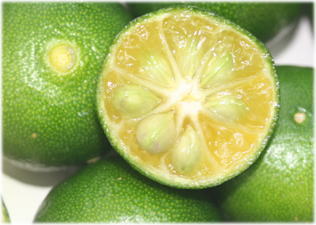
Shikuwasa is a tiny citrus fruit. From the outside it is green, but has more of a yellow flesh. It is sour and reminded us of lemons and limes, but it had an unique flavor all its own and we were all in Heaven eating our popsicles! This fruit is awesome! (Before I forget, I would like to mention the Okinawan bananas, which are super sweet! They are so much smaller in size from what we find in America, but the flavor is better and sweeter!)
There were some picnic tables at Nakijin-jo and we sat at them to eat our bento boxes for lunch. (The tables were in the sun and we were sweating to death.) Bento boxes are sold all over Japan. We have often seen vendors selling them on the sidewalks of Tokyo around lunchtime. We also see them in convenience stores. I bought a few different bentos for the kids to choose from. All of them contained some rice, vegetables, and meat. They also come with chopsticks. Kiyoko san was impressed at the kids' abilities to eat with chopsticks.
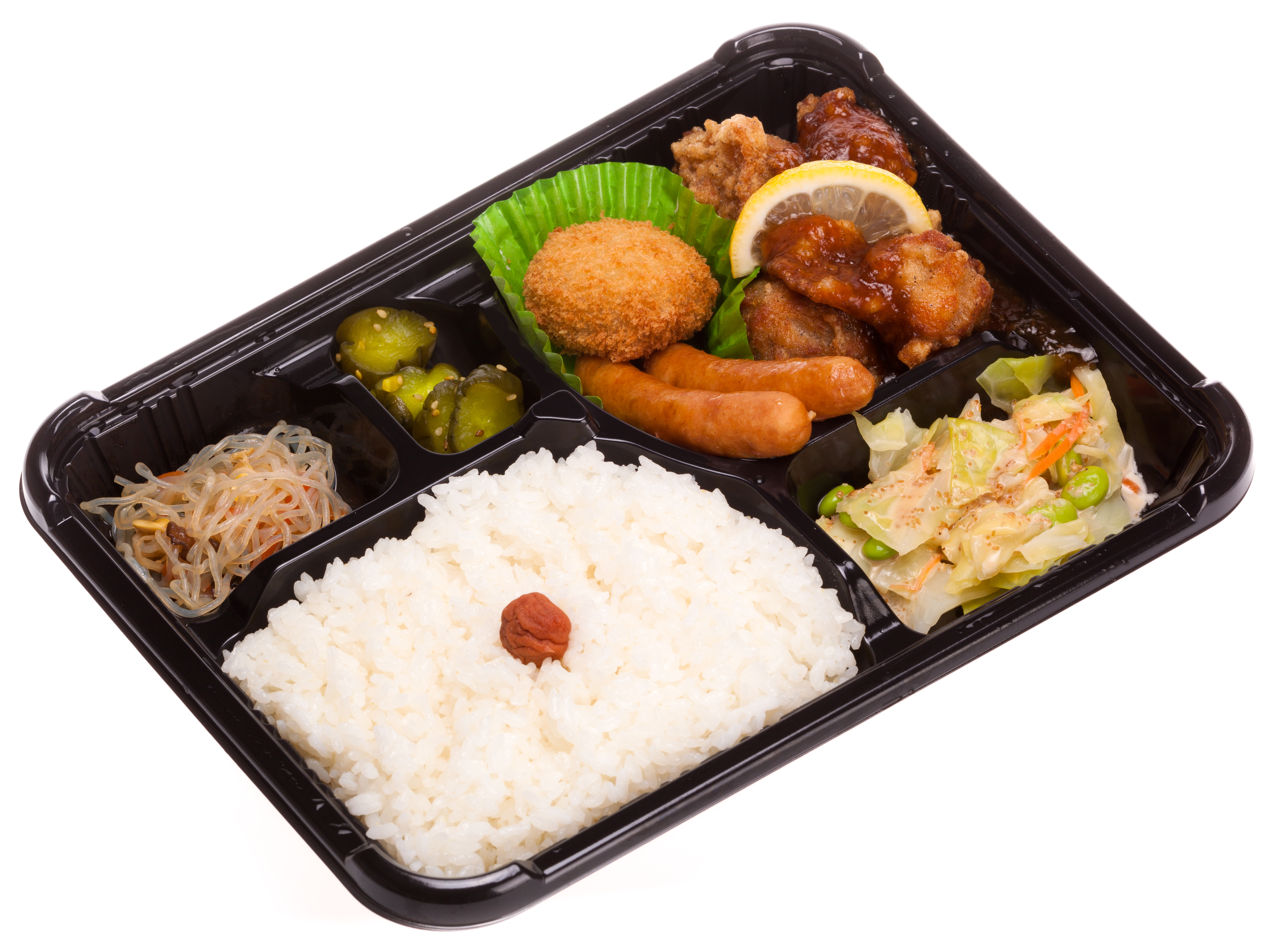

Sometimes the bentos are arranged in fun ways, such as a rice and seaweed Hello Kitty. As is typical for the Japanese, everything is always orderly and appealing to the eye. I thought I had taken a picture of the bento box that I ate, but later I couldn't find any pictures of it. Mine had cooked carrot slices that were cut into the shape of cherry blossoms.
The food in the bento boxes were yummy. I thought that these would be more than enough for the kids considering how hot it was, but the food was so good that they ate everything and wanted more.
After lunch, it was finally time to explore the Nakijin-jo Castle ruins. Kiyoko san went and sat in the shade and told Mimi to go with us. Here is Nathan by the sign for the castle.
There are many castle ruins all over Okinawa. Many centuries ago, there were several small kingdoms all over the island and each kingdom had their own castle or fortress. We wanted to explore several of these ruins, but due to time and how hard it is to get around the island, Nakijin-jo is the only one we were going to be able to see.
Nakijin Castle was built in the late 1200s. According to a Chinese book from the 14th century, the island of Okinawa went from several small kingdoms to being divided into just three kingdoms: the Hokuzan in the north, the Chuzan in the middle and the Nanzan in the south. Nakijin served as the castle of the Hokuzan king. This kingdom traded independently with China. It was taken over by the Chuzan on their way to unifying the island and forming the Ryukyu Kingdom. Once the entire island became part of the Ryukyu Kingdom, the whole island was ruled over by the king at Shuri Castle and the rest of the castles went into disrepair. The space was large and open. The walls were tall and very thick. Dotted all over were Easter lilies. If you look close in this picture, you can see the white lilies near the castle wall.
This was a kitchen for the castle. Fires would be built in the shelter so that food could be cooked. The Easter lilies were so beautiful.
Our crew enjoying a moment in the shade. Left to right: Caitlin, Audra, Raymond with Kirstin in his backpack, Mimi, Nathan, Chris, Tayla, and Logan.
The Okinawa version of a dandelion.
The entrance to the main part of the castle.
Through the centuries, the rocks that made up some of the walls and buildings have collapsed and crumbled. Where this was once a busy fortress filled with people who worked and served the king that lived here, now trees and foliage do their best to grow over the castle remains.It was thought that the castle wall at the bottom of this picture was the edge of Nakijin, but recent excavations have discovered more ruins beyond the ravine. There was also a sign that suggested that the ravine may have been built by the people of Hokuzan to be used as a waterway.
Making our way up some rock stairs.
This was a sacred area of the ruins. Nathan is checking out some kanji on a stone, Mimi is in the middle, and Tayla and Christopher are reading a sign explaining how people would pray at this place.
One of the views of Nakijin Castle near the top with the ocean in the background.
The addition of the Easter lilies growing between the rocks make this scene simply stunning!
This place is crawling with Easter lilies! It has an amazing view of the ocean and if you add in the history of what happened here many centuries ago, it makes this place truly special! We LOVE this place!!Most of the kids--we are just missing Kirstin who was on Raymond's back. Audra was having a "three year old moment" and couldn't stop her fit long enough to take a picture.
This is the main shrine used for worshipping at the castle. The stone lanterns honored the Hokuzan king and other prominent people of the kingdom.
Climbing down these stairs in the sweltering sun and humidity. Coming down these stairs, we were able to get super close to the walls and observe how they were made. There was no mortar to hold them together, nor were they cut in a way so that they could fit together neatly. The rocks were just set in humongous piles until they made these impressive walls.
Another type of wild flower, growing on a hillside. These flowers picked a good spot to grow, they have a nice view of the ocean.These stones were excavated in this spot and left to show the position and size of some of the servants' houses.
The homes were small and this area is in the back of the castle. This area was probably less protected compared to other parts of the castle, but the feeling here combined with the view made this place special to us. You can see some of the kids sitting on the stones that are outlining the small homes. It was peaceful here, and we spent a few minutes resting.
Even after the island became controlled by the government run from Shuri Castle and Nakijin ceased to be a place of political importance, this site remained a spiritual center for the people of Okinawa. Worshippers still came from throughout the island to this place.
This spot has been excavated and shows some type of foundation. There was probably a building here at one time.
We really enjoyed walking all over Nakijin! We found it to be beautiful and interesting.
Unfortunately, we eventually saw all that there was to see.
As we were walking back to the place where we had left Kiyoko san, we found a little shack with a very old man working in it. He was making a drink out of sugar cane and offered us some samples. We were very eager to try it out and asked him to show us how he made it. He had a grinder that he would put the dried sugar cane through. Then, he would take the ground up sugar cane and boil it for several hours, which would release the sugars into the water. It was very concentrated stuff and he sold it in bottles. Each bottle cost 1000 yen ($10). He recommended putting just a small amount of the concentrated sugar cane liquid into a glass and then diluting it with water. The sample he gave us was very sweet and very good. We considered buying a bottle from him, but he was also selling a concentrated bottle of shikuwasa juice. Since we had just tried his sugar cane juice by enjoying the sample that he gave us, we decided to buy a bottle of concentrated shikuwasa juice. This was also 1000 yen and also needed to be heavily diluted. (We used this bottle to make shikuwasa juice for breakfast over the next few days.)
Since we were all very parched from walking all over the castle ruins in the heat and we couldn't drink the concentrated juice that we had just bought, Dad bought a soda for all of us to share. It also had shikuwasa juice in it. HOLY MOLY! The. best. soda. ever. EVER. Mimi was getting used to us by now and was just a part of the family and joined in on taking a turn getting a drink from the soda can with everyone else. She is a sweetheart and we all agreed that we want to adopt her.
After the soda was gone, we walked over to the Nakijin Village History and Culture Center which is a small museum displaying items that have been found during the excavation of the castle grounds. We couldn't take pictures in the museum, unfortunately. We saw things such as blue and white pottery, coins, and documents. There were also tools and farm equipment. We examined exhibits about the everyday life and culture of the Nakijin Village many centuries ago. It was all pretty neat, especially since we had just walked all over the Nakijin Castle.
Nakijin Castle is beautiful and an important part of Okinawan history. We wish we could explore some of the other castle ruins that dot the island, but feel blessed that we were able to see Nakijin!











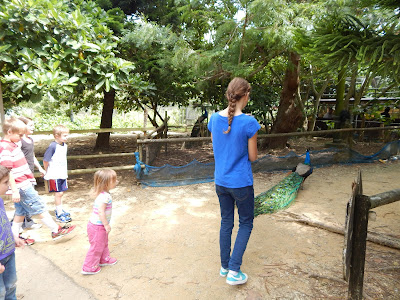
















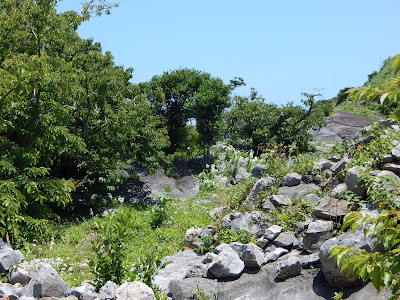

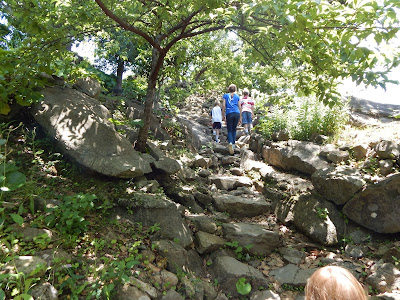



















The tree is a Sausage Tree (Kigelia pinnata) and it's really cool. The flower is a Bird of Paradise and is even cooler. What a wonderful day you guys had.
ReplyDeleteThe tree is a Sausage Tree (Kigelia pinnata) and it's really cool. The flower is a Bird of Paradise and is even cooler. What a wonderful day you guys had.
ReplyDelete